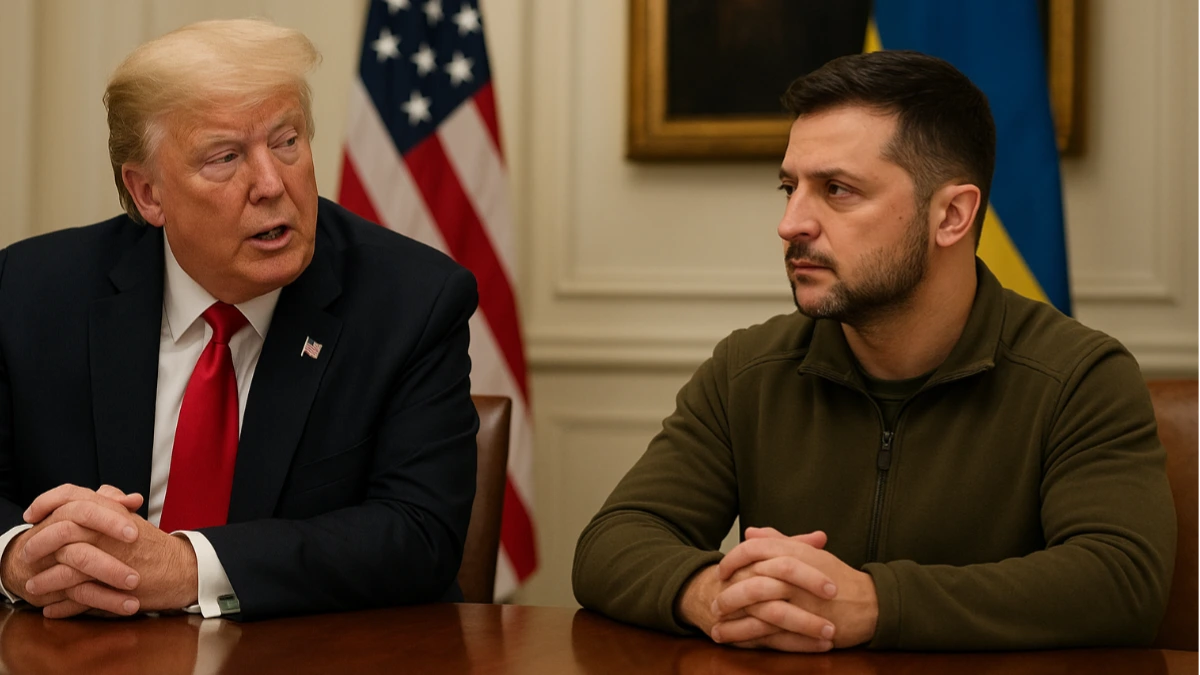WASHINGTON — President Donald Trump appeared reluctant Friday to grant Ukrainian President Volodymyr Zelenskyy’s request for Tomahawk missiles, despite asserting confidence that Russian President Vladimir Putin “wants to end this war.”
The hesitation underscores Trump’s balancing act between deterrence and diplomacy as the conflict nears its third year.
During a meeting at the White House, Zelenskyy urged Trump to authorize the delivery of long range Tomahawk cruise missiles to bolster Ukraine’s defenses and pressure Moscow at the negotiating table.
Trump stopped short of rejecting the request outright but warned that providing such advanced weaponry could escalate the war.
“Tomahawks are a big deal,” Trump said. “They’re a very powerful weapon, but they’re a very dangerous weapon, and it could mean a lot of bad things can happen.”
Zelenskyy’s latest visit his third to Washington this year came as Kyiv seeks to regain momentum on the battlefield.
Ukrainian officials believe that long range strike capabilities such as Tomahawks could help cripple Russian command centers and logistics deep inside its territory.
The meeting followed a flurry of diplomatic activity by the Trump administration. Earlier this week, Trump announced that India agreed to halt its purchases of Russian oil, while Senate Republicans are preparing to vote on a new sanctions package targeting Moscow.
Defense Secretary Pete Hegseth, speaking to NATO allies in Brussels, vowed that Russia must face “serious consequences” for its invasion. Riding the wave of a recent Middle East peace deal, Trump has also engaged directly with Putin.
He said the two leaders spoke for more than two hours Thursday and plan to meet in Budapest within weeks. “I think President Putin wants to end the war,” Trump told reporters.
Military analysts warn that transferring Tomahawk missiles could dramatically shift the war’s dynamics and widen U.S. involvement. The missiles, capable of striking targets up to 1,500 miles away, are a cornerstone of US naval power.
“Sending Tomahawks would cross a threshold that Washington has avoided since the start of the conflict,” said Elena Bartov, a senior fellow at the Atlantic Policy Institute. “It would give Ukraine the ability to hit deep inside Russia, which risks direct confrontation.”
Tom Karako, director of the Center for Strategic and International Studies’ Missile Defense Project, said the United States has limited stockpiles.
We’ve been consuming Tomahawks like candy, he said. “The US Navy needs them for its own deterrence missions in the Middle East and the Pacific. Realistically, only a few hundred could be sent, not thousands.”
The Tomahawk, developed in the 1980s, has been a mainstay of American military operations in the Middle East. Each missile carries a 1,000 pound warhead and travels at subsonic speeds close to the ground, making it difficult for radar systems to detect.
The US has launched Tomahawks in conflicts in Iraq, Syria, and Yemen, often with high precision and minimal pilot risk. However, the rate of recent use including more than two dozen missiles fired in recent strikes on Iranian facilities has strained production lines.
Ukraine’s military currently relies heavily on shorter range Western systems such as HIMARS rockets and Storm Shadow missiles provided by Britain and France.
Ukrainian defense officials argue that Tomahawks could “change the situation on the battlefield” by allowing deeper, more coordinated strikes.
Zelenskyy, visibly disappointed but measured after the meeting, reiterated that Ukraine’s goal remains a negotiated peace.
“We understand what we need to push Putin to the negotiation table,” he said. He added that Ukraine could offer to share advanced drone technology in exchange for Tomahawk deliveries.
Ukrainian officials privately expressed concern that Trump’s outreach to Putin might delay military support.
“We will show how Tomahawks can change the situation at war,” said a senior Ukrainian defense adviser. “But if we don’t get them soon, it may be too late for this winter.”
European diplomats struck a cautious tone. “We hope this conversation, if it takes place, will be used to increase pressure on Putin peace through strength,” said one European official familiar with the discussions.
In Kyiv, residents following the talks voiced mixed reactions. “We want peace, but we also want dignity,” said Olena Kovalenko, a teacher in the capital.
“If Tomahawks bring Russia to the table, give them to us. But if not, then we need another path.” Trump’s upcoming meeting with Putin in Budapest could mark a turning point or deepen skepticism among allies.
The Ukrainian president is not expected to attend, a point Trump emphasized by noting “bad blood” between Zelenskyy and Putin as a major obstacle to negotiations.
“It’s possible Putin is playing for time,” Trump said when asked whether he trusted the Russian leader’s intentions. “I’ve been played all my life by the best of them, and I came out really well. But I think he wants to make a deal.”
US officials said discussions with Ukraine will continue in the coming weeks, including on air defense systems and economic aid. Any decision on Tomahawk transfers would likely require congressional approval.
For now, Trump’s restrained approach signals a preference for diplomacy over escalation, even as Ukraine pleads for greater military assistance.
His faith that Putin “wants to end the war” contrasts sharply with the skepticism in Kyiv and among NATO partners who have seen similar overtures collapse before.
Whether Trump’s diplomatic gamble pays off or emboldens Moscow further may hinge on what happens in Budapest.
Until then, the question of Tomahawks remains unresolved, hovering over a war that shows few signs of truly ending.

